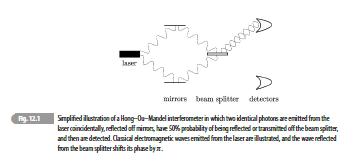The HongOuMandel interferometer is an experiment in which two identical photons are emitted from a laser toward
Question:
The Hong–Ou–Mandel interferometer is an experiment in which two identical photons are emitted from a laser toward separate mirrors that then reflect onto a beam splitter and can subsequently be detected.1 When a photon hits the beam splitter, or half-silvered mirror, it has 50% probability of transmission and 50% probability of reflection. Two detectors are placed at the end of the experiment, and there are three possible observations: either one photon hits each detector, two photons hit one detector and no photons hit the other, or vice-versa. The experimental set-up is illustrated in Fig. 12.1.

The beam splitter is the key device in this experiment and it has the important property that it can affect the phase of the photons that hit it. Recall that light that passes through an interface of higher to lower index of refraction does not change phase. However, light that is reflected from the interface of lower to higher index of refraction changes phase by π. While the analysis is a bit subtle, for a beam splitter, the phase difference between light that passes through and light that is reflected is π. Because light has 50% chance of transmission or reflection, we can say that the light that is reflected has a phase shift of +π/2 and the light that is transmitted has a phase shift of −π/2, for a difference of π.2 With this set-up, in this example, we will determine what would be detected in the two detectors classically. That is, assuming that light is just a classical electromagnetic wave, would you ever observe a hit in one detector and nothing in the other detector?
Or, would you observe both detectors hit?
1 C. K. Hong, Z. Y. Ou, and L. Mandel, “Measurement of subpicosecond time intervals between two photons by interference,” Phys. Rev. Lett. 59(18), 2044 (1987).
2 V. Degiorgio, “Phase shift between the transmitted and the reflected optical fields of a semireflecting lossless mirror is π/2,” Am. J. Phys. 48, 81 (1980).
Step by Step Answer:

Quantum Mechanics A Mathematical Introduction
ISBN: 9781009100502
1st Edition
Authors: Andrew J. Larkoski





